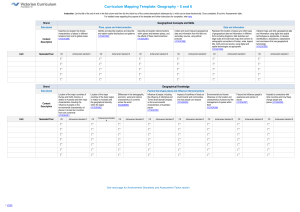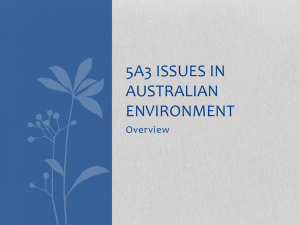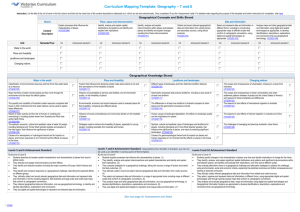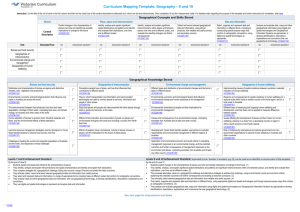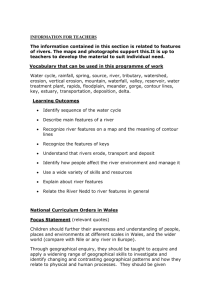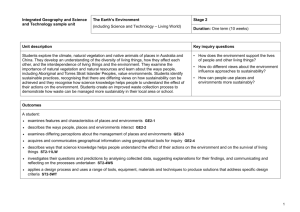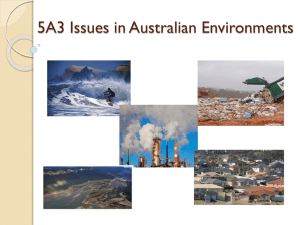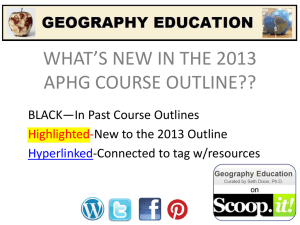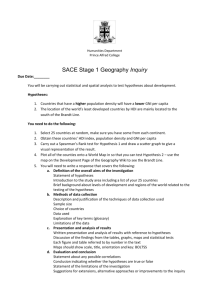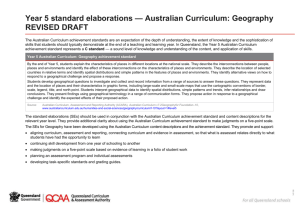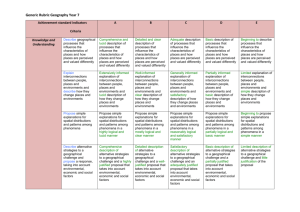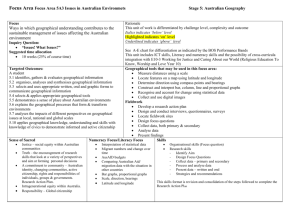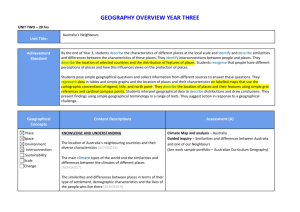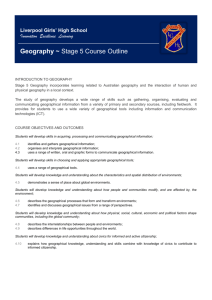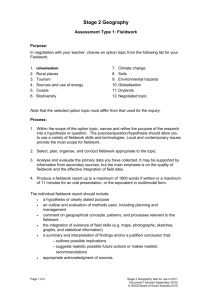Levels 3 and 4 (docx
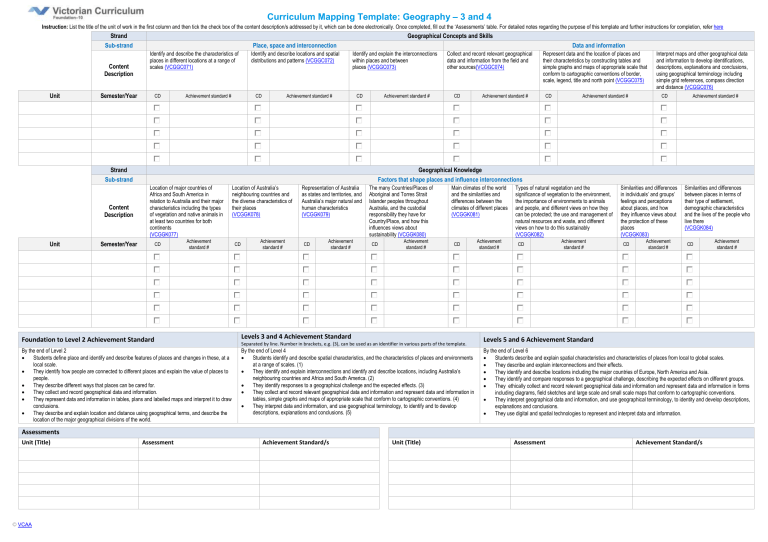
Curriculum Mapping Template: Geography – 3 and 4
Instruction: List the title of the unit of work in the first column and then tick the check box of the content description/s addressed by it, which can be done electronically. Once completed, fill out the ‘Assessments’ table. For detailed notes regarding the purpose of this template and further instructions for completion, refer here
Strand Geographical Concepts and Skills
Sub-strand
Content
Description
Identify and describe the characteristics of places in different locations at a range of scales (VCGGC071)
Place, space and interconnection
Identify and describe locations and spatial distributions and patterns (VCGGC072)
Identify and explain the interconnections within places and between places (VCGGC073)
Collect and record relevant geographical data and information from the field and other sources (VCGGC074)
Data and information
Represent data and the location of places and their characteristics by constructing tables and simple graphs and maps of appropriate scale that conform to cartographic conventions of border, scale, legend, title and north point (VCGGC075)
Interpret maps and other geographical data and information to develop identifications, descriptions, explanations and conclusions, using geographical terminology including simple grid references, compass direction and distance (VCGGC076)
Unit Semester/Year
CD Achievement standard # CD Achievement standard # CD Achievement standard # CD Achievement standard # CD Achievement standard # CD Achievement standard #
Unit
Strand
Sub-strand
Content
Description
Semester/Year
Location of major countries of
Africa and South America in relation to Australia and their major characteristics including the types of vegetation and native animals in at least two countries for both continents
(VCGGK077)
CD
Achievement standard #
CD
Location of Australia’s neighbouring countries and the diverse characteristics of their places
(VCGGK078)
Achievement standard #
Representation of Australia as states and territories, and
Australia’s major natural and human characteristics
(VCGGK079)
CD
Achievement standard #
Geographical Knowledge
Factors that shape places and influence interconnections
The many Countries/Places of
Aboriginal and Torres Strait
Islander peoples throughout
Australia, and the custodial responsibility they have for
Country/Place, and how this influences views about sustainability (VCGGK080)
CD
Achievement standard #
Main climates of the world and the similarities and differences between the climates of different places
(VCGGK081)
CD
Achievement standard #
Types of natural vegetation and the significance of vegetation to the environment, the importance of environments to animals and people, and different views on how they can be protected; the use and management of natural resources and waste, and different views on how to do this sustainably
(VCGGK082)
CD
Achievement standard #
Similarities and differences in individuals’ and groups’ feelings and perceptions about places, and how they influence views about the protection of these places
(VCGGK083)
CD
Achievement standard #
Similarities and differences between places in terms of their type of settlement, demographic characteristics and the lives of the people who live there
(VCGGK084)
CD
Achievement standard #
Foundation to Level 2 Achievement Standard
By the end of Level 2
Students define place and identify and describe features of places and changes in these, at a local scale.
They identify how people are connected to different places and explain the value of places to people.
They describe different ways that places can be cared for.
They collect and record geographical data and information.
They represent data and information in tables, plans and labelled maps and interpret it to draw conclusions.
They describe and explain location and distance using geographical terms, and describe the location of the major geographical divisions of the world.
Assessments
Unit (Title) Assessment
Levels 3 and 4 Achievement Standard
Separated by line. Number in brackets, e.g. (3), can be used as an identifier in various parts of the template.
By the end of Level 4
Students identify and describe spatial characteristics, and the characteristics of places and environments at a range of scales. (1)
They identify and explain interconnections and identify and describe locations, including Australia’s neighbouring countries and Africa and South America. (2)
They identify responses to a geographical challenge and the expected effects. (3)
They collect and record relevant geographical data and information and represent data and information in tables, simple graphs and maps of appropriate scale that conform to cartographic conventions. (4)
They interpret data and information, and use geographical terminology, to identify and to develop descriptions, explanations and conclusions. (5)
Achievement Standard/s Unit (Title)
Levels 5 and 6 Achievement Standard
By the end of Level 6
Students describe and explain spatial characteristics and characteristics of places from local to global scales.
They describe and explain interconnections and their effects.
They identify and describe locations including the major countries of Europe, North America and Asia.
They identify and compare responses to a geographical challenge, describing the expected effects on different groups.
They ethically collect and record relevant geographical data and information and represent data and information in forms including diagrams, field sketches and large scale and small scale maps that conform to cartographic conventions.
They interpret geographical data and information, and use geographical terminology, to identity and develop descriptions, explanations and conclusions.
They use digital and spatial technologies to represent and interpret data and information.
Assessment Achievement Standard/s
© VCAA

